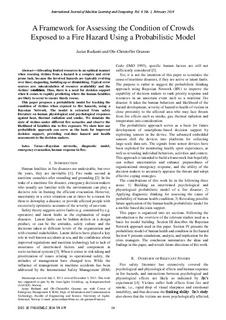| dc.contributor.author | Radianti, Jaziar | |
| dc.contributor.author | Granmo, Ole-Christoffer | |
| dc.date.accessioned | 2014-12-11T09:18:17Z | |
| dc.date.available | 2014-12-11T09:18:17Z | |
| dc.date.issued | 2014 | |
| dc.identifier.citation | Radianti, J., & Granmo, O.-C. (2014). A framework for assessing the condition of crowds exposed to a fire hazard using a probabilistic model. International Journal of Machine Learning and Computing, 4(1), 14-20. doi: 10.7763/IJMLC.2014.V4.379 | nb_NO |
| dc.identifier.issn | 2010-3700 | |
| dc.identifier.uri | http://hdl.handle.net/11250/226948 | |
| dc.description | Published version of an article in the journal: International Journal of Machine Learning and Computing. Also available from the publisher at: http://dx.doi.org/10.7763/IJMLC.2014.V4.379 open Access | nb_NO |
| dc.description.abstract | Allocating limited resources in an optimal manner when rescuing victims from a hazard is a complex and error prone task, because the involved hazards are typically evolving over time; stagnating, building up or diminishing. Typical error sources are: miscalculation of resource availability and the victims’ condition. Thus, there is a need for decision support when it comes to rapidly predicting where the human fatalities are likely to occur to ensure timely rescue. This paper proposes a probabilistic model for tracking the condition of victims when exposed to fire hazards, using a Bayesian Network. The model is extracted from safety literature on human physiological and psychological responses against heat, thermal radiation and smoke. We simulate the state of victims under different fire scenarios and observe the likelihood of fatalities due to fire exposure. We show how our probabilistic approach can serve as the basis for improved decision support, providing real-time hazard and health assessments to the decision makers. | nb_NO |
| dc.language.iso | eng | nb_NO |
| dc.publisher | IACSIT Press | nb_NO |
| dc.subject | Bayesian networks | nb_NO |
| dc.subject | diagnostic model | nb_NO |
| dc.subject | emergency evacuation | nb_NO |
| dc.subject | human response in fire | nb_NO |
| dc.title | A framework for assessing the condition of crowds exposed to a fire hazard using a probabilistic model | nb_NO |
| dc.type | Journal article | nb_NO |
| dc.type | Peer reviewed | nb_NO |
| dc.subject.nsi | VDP::Mathematics and natural science: 400::Information and communication science: 420::Algorithms and computability theory: 422 | nb_NO |
| dc.subject.nsi | VDP::Technology: 500::Information and communication technology: 550 | nb_NO |
| dc.source.pagenumber | 14-20 | nb_NO |
| dc.source.volume | 4 | nb_NO |
| dc.source.journal | International Journal of Machine Learning and Computing | nb_NO |
| dc.source.issue | 1 | nb_NO |
| dc.identifier.doi | 10.7763/IJMLC.2014.V4.379 | |
